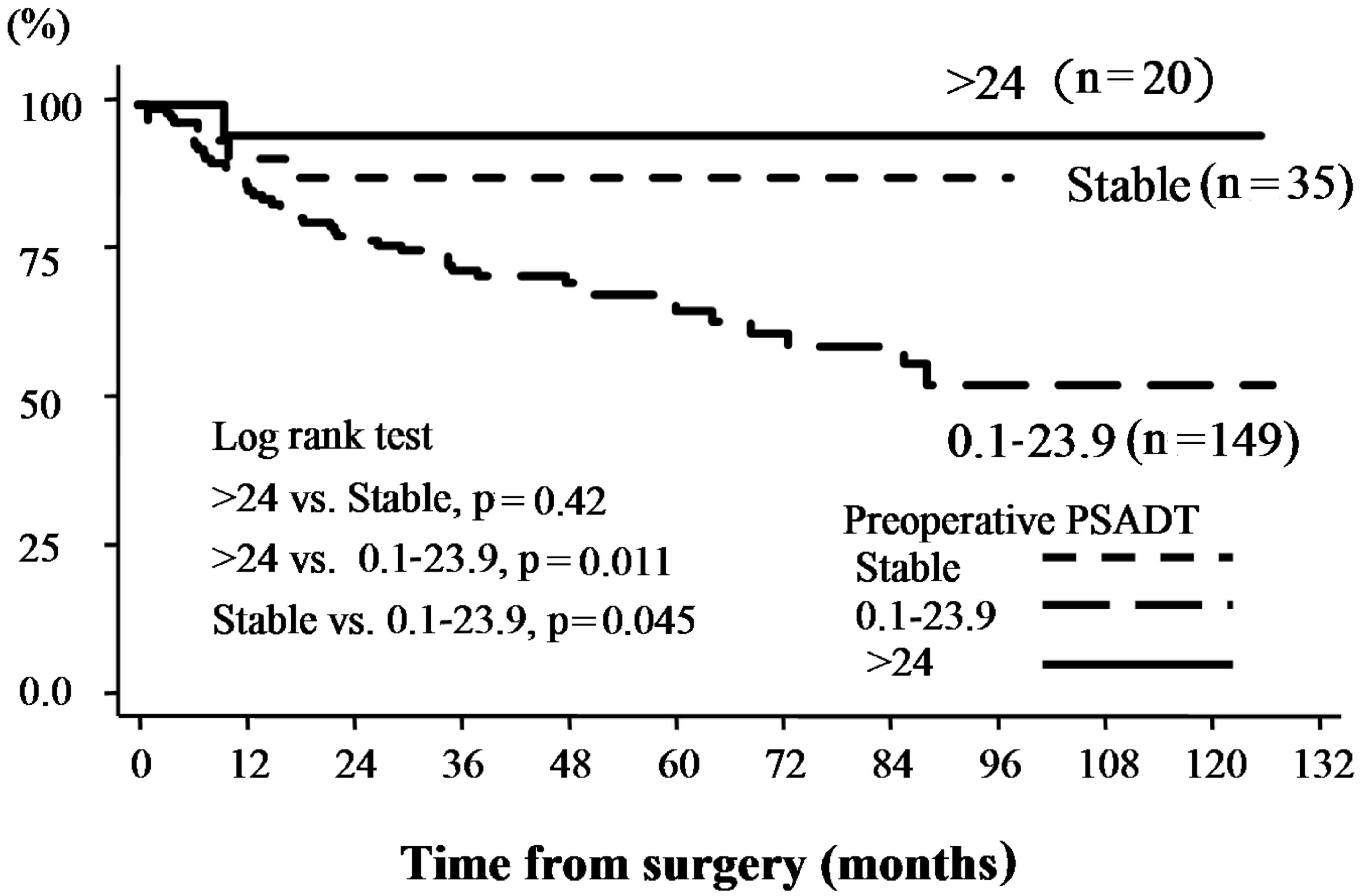|
1
|
Catalona WJ, Smith DS, Ratliff TL, Dodds
KM, Coplen DE, Yuan JJJ, Petros JA and Andriole GL: Measurement of
prostate-specific antigen in serum as a screening test for prostate
cancer. N Engl J Med. 324:1156–1161. 1991. View Article : Google Scholar : PubMed/NCBI
|
|
2
|
Loeb S, Roehl KA, Helfand BT, Kan D and
Catalona WJ: Can prostate specific antigen velocity thresholds
decrease insignificant prostate cancer detection? J Urol.
183:112–116. 2010. View Article : Google Scholar : PubMed/NCBI
|
|
3
|
Carter HB, Morrell CH, Pearson JD, Brant
LJ, Plato CC, Metter EJ, Chan DW, Fozard JL and Walsh PC:
Estimation of prostatic growth using serial prostate-specific
antigen measurements in men with and without prostate disease.
Cancer Res. 52:3323–3328. 1992.PubMed/NCBI
|
|
4
|
Nam RK, Klotz LH, Jewett MAS, Danjoux C
and Trachtenberg J: Prostate specific antigen velocity as a measure
of the natural history of prostate cancer: Defining a ‘rapid riser’
subset. Br J Urol. 81:100–104. 1998. View Article : Google Scholar : PubMed/NCBI
|
|
5
|
D'Amico AV and Hanks GE: Linear regressive
analysis using prostate-specific antigen doubling time for
predicting tumor biology and clinical outcome in prostate cancer.
Cancer. 72:2638–2643. 1993. View Article : Google Scholar : PubMed/NCBI
|
|
6
|
McLaren DB, McKenzie M, Duncan G and
Pickles T: Watchful waiting or watchful progression?: Prostate
specific antigen doubling times and clinical behavior in patients
with early untreated prostate carcinoma. Cancer. 82:342–348. 1998.
View Article : Google Scholar : PubMed/NCBI
|
|
7
|
Lee WR, Hanks GE, Corn BW and Schultheiss
TE: Observations of pretreatment prostate-specific antigen doubling
time in 107 patients referred for definitive radiotherapy. Int J
Radiat Oncol Biol Phys. 31:21–24. 1995. View Article : Google Scholar : PubMed/NCBI
|
|
8
|
Goluboff ET, Heitjan DF, DeVries GM, Katz
AE, Benson MC and Olsson CA: Pretreatment prostate specific antigen
doubling times: Use in patients before radical prostatectomy. J
Urol. 158:1876–1878; discussion 1878–1879. 1997. View Article : Google Scholar : PubMed/NCBI
|
|
9
|
Arlen PM, Bianco F, Dahut WL, D'Amico A,
Figg WD, Freedland SJ, Gulley JL, Kantoff PW, Kattan MW, Lee A, et
al: Prostate Specific Antigen Working Group: Prostate Specific
Antigen Working Group guidelines on prostate specific antigen
doubling time. J Urol. 179:2181–2185; discussion 2185–2186. 2008.
View Article : Google Scholar : PubMed/NCBI
|
|
10
|
Egawa S, Matsumoto K, Suyama K, Iwamura M,
Kuwao S and Baba S: Observations of prostate specific antigen
doubling time in Japanese patients with nonmetastatic prostate
carcinoma. Cancer. 86:463–469. 1999. View Article : Google Scholar : PubMed/NCBI
|
|
11
|
Gerber GS, Gornik HL, Goldfischer ER,
Chodak GW and Rukstalis DB: Evaluation of changes in prostate
specific antigen in clinically localized prostate cancer managed
without initial therapy. J Urol. 159:1243–1246. 1998. View Article : Google Scholar : PubMed/NCBI
|
|
12
|
Smith MR, Kabbinavar F, Saad F, Hussain A,
Gittelman MC, Bilhartz DL, Wynne C, Murray R, Zinner NR, Schulman
C, et al: Natural history of rising serum prostate-specific antigen
in men with castrate nonmetastatic prostate cancer. J Clin Oncol.
23:2918–2925. 2005. View Article : Google Scholar : PubMed/NCBI
|
|
13
|
Schmid H-P, McNeal JE and Stamey TA:
Observations on the doubling time of prostate cancer. The use of
serial prostate-specific antigen in patients with untreated disease
as a measure of increasing cancer volume. Cancer. 71:2031–2040.
1993. View Article : Google Scholar : PubMed/NCBI
|
|
14
|
Hanks GE, Hanlon AL, Lee WR, Slivjak A and
Schultheiss TE: Pretreatment prostate-specific antigen doubling
times: Clinical utility of this predictor of prostate cancer
behavior. Int J Radiat Oncol Biol Phys. 34:549–553. 1996.
View Article : Google Scholar : PubMed/NCBI
|
|
15
|
Sandler HM, Dunn RL, McLaughlin PW, Hayman
JA, Sullivan MA and Taylor JM: Overall survival after
prostate-specific-antigen-detected recurrence following conformal
radiation therapy. Int J Radiat Oncol Biol Phys. 48:629–633. 2000.
View Article : Google Scholar : PubMed/NCBI
|
|
16
|
Loberg RD, Fielhauer JR, Pienta BA,
Dresden S, Christmas P, Kalikin LM, Olson KB and Pienta KJ:
Prostate-specific antigen doubling time and survival in patients
with advanced metastatic prostate cancer. Urology 62 (Suppl 1).
128–133. 2003. View Article : Google Scholar
|
|
17
|
Semeniuk RC, Venner PM and North S:
Prostate-specific antigen doubling time is associated with survival
in men with hormone-refractory prostate cancer. Urology.
68:565–569. 2006. View Article : Google Scholar : PubMed/NCBI
|
|
18
|
Shulman MJ, Karam JA and Benaim EA:
Prostate-specific antigen doubling time predicts response to
deferred antiandrogen therapy in men with androgen-independent
prostate cancer. Urology. 63:732–736. 2004. View Article : Google Scholar : PubMed/NCBI
|
|
19
|
D'Amico AV, Moul JW, Carroll PR, Sun L,
Lubeck D and Chen MH: Surrogate end point for prostate
cancer-specific mortality after radical prostatectomy or radiation
therapy. J Natl Cancer Inst. 95:1376–1383. 2003. View Article : Google Scholar : PubMed/NCBI
|
|
20
|
Egawa S, Arai Y, Tobisu K, Kuwao S, Kamoto
T, Kakehi Y and Baba S: Use of pretreatment prostate-specific
antigen doubling time to predict outcome after radical
prostatectomy. Prostate Cancer Prostatic Dis. 3:269–274. 2000.
View Article : Google Scholar : PubMed/NCBI
|
|
21
|
Freedland SJ, Humphreys EB, Mangold LA,
Eisenberger M, Dorey FJ, Walsh PC and Partin AW: Risk of prostate
cancer-specific mortality following biochemical recurrence after
radical prostatectomy. JAMA. 294:433–439. 2005. View Article : Google Scholar : PubMed/NCBI
|










